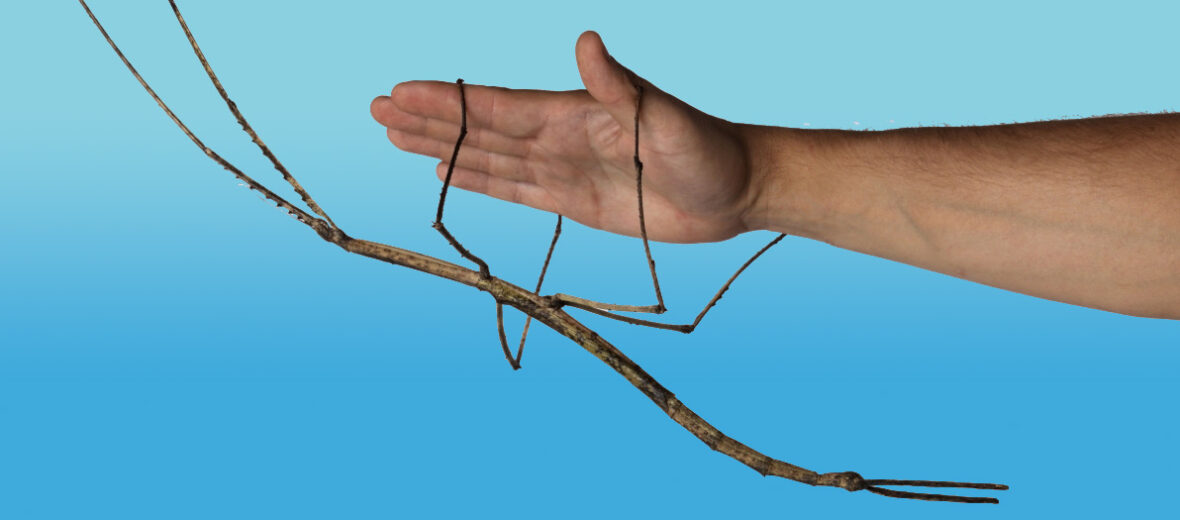
The giant walking stick is not a rod used for hiking rough terrain. Nope. These are the longest known insects in the world. A member of the Phasmatodea family, aka Phasmids, these critters are masters of camouflage. They blend right in and look like, well, sticks. Until they actually move. But even their general means of locomotion looks like a twig blowing in the wind. Due to their wide spread numbers all known walking stick insects are listed as either Least Concern or Data Deficient by the IUCN.
First the Stats…
Scientific name: Megaphasma denticrus
Weight: Up to 3 ounces
Length: Up to 25 inches
Lifespan: Up to 2 years
Now on to the Facts!
1.) Walking sticks are nocturnal (active at night).
2.) Known as parthenogenesis, female walking stick insects are capable of reproducing without the help of a male. When sticks are born in this fashion, there is only up to a 50% chance the offspring will contain males. There is a greater chance of females being hatched.
3.) Like chameleons, these insects tend to sway when they walk. This helps them resemble twigs blowing in the wind.
4.) Like white’s tree frogs or geckos, nymphs will tend to eat their own shed skin, or in this case exoskeleton. This aids them in recovering lost protein.
5.) In another act of camouflage, female walking sticks drop their eggs on the ground that look like seeds. This helps keep predators from eating the eggs before they even hatch.
But wait, there’s more on the giant walking stick!
6.) The eggs that look like seeds have a fatty substance at one end of the egg called capitulum. Ants happen to take a liking to capitulum and will often take the eggs back to their nest for a meal. Once the fatty capitulum is consumed, the ants discard the eggs onto a trash pile, where the egg continues to develop, safe from predators. Once hatched, the stick insect makes its way up a branch or tree to safety.
7.) They may be slow and look totally defenseless, once their camouflage fails them. However, stick insects come with a variety of defenses. Some can break their joints which then causes a stinky hemolymph to ooze out. Others emit a foul tasting chemical, still others can spray a gas-like substance at their attackers that causes transient blindness.
Did you know…?
Stick insects are able to regenerate lost limbs. In an act known as autotomy, they can even break off 1 or more legs when being attacked. The young will just regrow the lost limb during their next molt. Where adults can actually force themselves to molt again to regain the lost limb(s).
8.) In a defensive act known as flash coloration, the winged variants of stick insects will often flash their brightly colored wings at an attacker, confusing them long enough to cause the attacker to lose sight of the insect’s location.
9.) Most predators are attracted to movement. The more it moves, the tastier it must be, right? To counter this, if all other defenses fail, the stick insect will fall to the ground and remain motionless. This is called thanatosis. The apparently dead insect no longer appears alive and therefor no longer a tasty treat.
10.) Their predators are typically insectovorous (eat insects) mammals, reptiles, and birds.
But wait, there’s still more on the giant walking stick!
11.) Females can produce up to 1,200 eggs that are, as previously mentioned, scattered on the ground.
12.) Like other insects, the life cycle of a giant walking stick is egg, nymph, and finally adult insect.
13.) half of their lives are spent as nymphs and the remainder as adults.
14.) Some species of stick insects can also fly. Imagine an insect that long flying at you. Pretty impressive.
15.) Sexual dimorphism is strong with these insects. This is where the male and female are quite different in appearance. Males, in this case, are substantially smaller than females.
Now a Short Giant Walking Stick Video!
Be sure to share & comment below! Also, check out the Critter Science YouTube channel. Videos added frequently!
Want to suggest a critter for me to write about? Let me know here.



